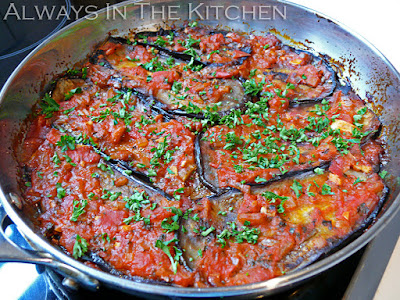
There are a lot of origin stories about Chicken Tikka Masala, and a lot of claims to ownership. As far as I can tell, there's no way to even verify which country the dish originated in, let alone the specific claimant.
Some folks will tell you that this is not a proper curry, but that is quite ridiculous. It may not be a historical dish, but it's in no way illegitimate because of that. It's delicious and acceptable and popular. At it's heart, it is derived from an Indian tandoori dish called Chicken Tikka - marinated chicken cooked in a tandoor (Indian clay oven), although according to Wikipedia, the Punjabi version is simply cooked over coals. The chicken is usually marinated in yoghurt and spices, and is typically cut into chunks and cooked on skewers. Where the masala bit comes in, is when you take a perfectly good (or maybe a little dry?) Chicken Tikka, and simmer it gently in a spiced tomato sauce, enriched with yoghurt at the end. There are, of course, many iterations, including one of the origin stories, which claims that an undiluted can of Campbell's Tomato Soup was the base of the sauce.
There is likely no place on earth where Chicken Tikka Masala is more popular than the UK, where it appears to be fast approaching (or even edging out) the traditional Sunday roast as most beloved national dish. You can get Chicken Tikka Masala pre-packaged sandwiches in the Tesco, which gives you an idea of the market penetration of the dish.
Versions of Chicken Tikka Masala that are made using commercial Tandoori paste often have a pink tone to the gravy and the outer surface of the chicken itself. Since that is derived using a food colouring that I don't usually have in my kitchen, I skipped it and simply went with a turmeric-forward spice mixture that is often used for Chicken Tikka. If yours must be pink, skips the spices listed below in favour of the commercial paste, and slather the chicken pieces liberally with it.
I don't have a tandoor oven, which is probably no surprise, nor do I have a kitchen set-up conducive to cooking with coals. This is my home kitchen version, adapted from many different sources, but this one from Palachinkablog in particular.
Chicken Tikka Masala
Serves 4
2 tablespoons ghee or vegetable oil, divided
400 grams boneless chicken, in chunks
2 tablespoons turmeric
2 tablespoons ground cumin
1 tablespoon cayenne
1 teaspoon ground coriander seed
1/2 teaspoon kosher salt
1 large onion, grated
4-5 cloves garlic, pressed
1 inch fresh ginger, grated
500 mL tomato passata (or unseasoned tomato purée)
1/2 teaspoon sugar (optional)
1 cup full-fat plain yoghurt
1 tablespoon cornstarch
As always with Indian food, prep your mise en place completely before you start cooking. Put your basmati rice on to soak in its cooking water, too. Start to cook the rice just before you start to cook the chicken (unless you are using a rice cooker, in which case, time it to be ready when the chicken is done - about a 35 minute total cook time).
Combine all of the dry spices except the salt, and toss the chicken pieces in the mixture until they are all nicely coated. Set aside. You can do this in the morning, or at any point during the day, but bring back up to room temperature before cooking.
In a large skillet or a dutch oven, heat half the oil or ghee very hot and sear the chicken in batches, without cooking through, and remove the chicken to a holding plate as you go. When all the chicken is seared, add the rest of the oil and the grated onion, pressed garlic, and grated ginger, and any accumulated juices therefrom. Stir and scrape the pan, add the salt, and continue sautéing the onion mixture for about 5 minutes or so until just tender. Turn down the heat to medium-low and add the passata, and stir and scrape to ensure that the bottom is free of any stuck-on bits. After a couple of minutes, taste the sauce. If it is a little bitter from the tomato addition, add the sugar. If not, just proceed.
Add the seared chicken (and any residual spices) into the sauce, and turn the heat to its lowest setting. Let the chicken simmer very gently for 15 - 20 minutes. Take the pan off the heat. Combine the yoghurt and cornstarch and stir until smooth. Add a bit of the tomato sauce to the yoghurt, and stir it in, before adding all of the yoghurt mixture into the dutch oven. Stir through, watching to colour lighten and turn orangey. Cover and let the residual heat cook the cornstarch for about five minutes - just enough time to fry up some Indian-spiced Cabbage on the side, or make a fresh chutney or maybe a grated carrot salad, since your grater is already out. Your rice should also be done (and waiting patiently). If you happen to have some cilantro on hand, that would make a very nice garnish.



















